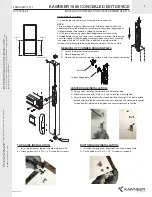
Function of each terminal, figure 18
Terminal block A
~
mains
~
Terminal block B
+B
input 12V DC
5
ground
21
output 11V DC
8
call common output 1
8A
call common output 2
11
audio from entry panel
12
audio to entry panel
23
output 14V AC
16
NO
normally open
relay
C
common
contacts
NC
normally closed
Terminal block C
5
ground
8
audio to receiver
9
audio from receiver
Technical features
• Supply voltage: 230V ±10% 50/60
Hz. The transformer primary is
electronically protected against
overloading and short circuiting i.e.
no fuses are used.
The unit can be powered from a 12
V DC power supply, e.g. battery or
uninterruptable power supply (ter-
B and 5).
NOTE.
The unit has no battery pro-
tection.
• Rated power: 15 VA.
• Output voltages:
11 VDC, 150 mA (300mA peak)
14 VAC, 650 mA (1 A in intermittent
current).
• Call generator: 2 types of two-tone
call (up to 3 handset can be con-
nected in parallel to the same call).
• Working temperature range: from 0
°C to +35 °C.
• Dimensions: 4 DIN units module,
low profile, figure 19.
NOTE. The transformer power sup-
plier primary is electronically protec-
ted against overloading and short cir-
cuiting i.e. no fuses are used.
Procedure to reset a triggered circuit:
- Disconnect the mains from the
power supplier
- Remove the cause of malfunction
- Let the power supplier to cool for at
least 1 min.
- Reconnect the mains to the power
supplier.
A/200N POWER SUPPLIER
With the same features of A/200R,
has also the following function:
- Power supply and control of electric
lock (12V AC, 1A) by means of relay
(inside the unit) with timer-controlled
interval adjustable from 2 to 15 s by
means of potentiometer
P1
, figure 20.
• Dimensions: 6 DIN units module,
low profile, figure 21.
INSTALLATION
YC/200 handset
First, remove the housing (fig. 1) and
fasten the base directly to the wall
(fig. 2) or to the embedding box (fig.
3 or 4).
If walls are not perfectly level, do not
overtighten screws.
Make wiring connections and refit the
handset cover.
Surface-mounted entry panel
Using the Allenkey s 2.5 supplied,
unscrew the lock screw and remove
the front plate from the base (fig. 6).
Fit the embedding box (3-module or
round Ø 65 mm version) flush with
the wall at an appropriate height.
Fasten the base onto the wall using
the screws and screw anchors sup-
plied (fig. 7).
Remove the cable-clamp plate and
perform the wiring (fig. 9).
In those installations liable to be
affected by the Larsen effect, the
microphone can be fitted in a remote
position, as indicated in fig. 8.
Refit the cable-clamp plate.
The name card can be removed and
filled in with the relevant information
by removing the card clip followed by
the actual card itself (fig. 10).
NOTE. Personalized name cards can
be used up to a maximum of 2 mm
thick.
In order to fit the front plate, first
insert the upper part in the top moul-
ding and then tighten the lock screw
(fig. 11).
Recessed entry panel
The embedding box must be fitted
flush with the wall at an appropriate
height.
Fit the spacer into embedding boxes to
avoid deformation (fig. 12).
Using the Allenkey s 2.5 supplied,
unscrew the lock screw and remove
the front plate from the chassis (fig.
13).
Remove the two plugs protecting the
threaded holes in the embedding box
and secure the chassis using the two
screws supplied (fig. 15).
Remove the cable-clamp plate and
perform the wiring (fig. 15).
In those installations liable to be
affected by the Larsen effect, the
microphone can be fitted in a remote
position, as indicated in fig. 14.
Refit the cable-clamp plate.
The name card can be removed and
filled in with the relevant information
by removing the card clip followed by
the actual card itself (fig. 10).
NOTE. Personalized name cards can
be used up to a maximum of 2 mm
thick.
In order to fit the front plate, first
insert the upper part in the top moul-
ding and then tighten the lock screw
(fig. 16).
A/200R-A/200N power supplier
The equipment can be installed
without terminal covers into boxes
provided with DIN rail (EN 50022).
Dimensions are shown in figure 19A-
21A.
It can also be surface mounted,
using the DIN rail supplied, but fitted
with terminal covers.
Dimensions are shown in figure 19B-
21B.
3
5
21
8
11
12
14
16
5
21
8
11
12
14
15
5
21
8
11
12
14
17
A
5 8
+B 5 21 8 8A 11 12 23 16 NO C NC
9
B
C
P1
20
A
B
NC
C
B
C
+B
5
21
8
8A
11
12
5
8
9
16
23
NO
18
43,5
45
7,5
57
70
106
A
B
64,5
70
145
19


























